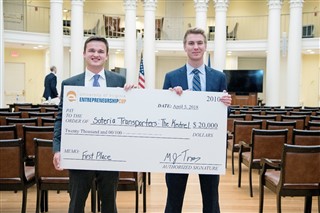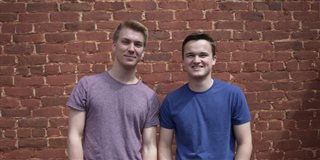Premature births accounted for approximately 10% of births in 2016, according to the CDC. These infants, who usually are also underweight, are most at risk, having a 17% fatality rate in 2015. This group of premature infants requires the utmost care and safety when being transported, but studies have found that trauma in infants caused during neonatal transport is a widespread problem across the United States.
 Soteria (pronounced soh-tehr-ee-yah or soh-tehr-ee-yah) Transporters, taking its name from the Greek goddess and Greek word representing safety, deliverance, and preservation from harm, is designing a new neonatal transporter to combat infant injuries sustained during medical transportation. The Soteria team has named their transporter the Kestrel after the American Falcon of the same name, the smallest and most common hawk in North America. The kestrel hawk perfectly symbolizes the Soteria team’s goal for their invention to become the most common transporter system for “our smallest citizens,” as phrased in the Soteria mission statement. “We’re trying to protect premature infants by isolating them from outside stress,” states Erik Quigg, CTO and co-founder of Soteria Transporters. “I hope it becomes the new standard of care for infant transportation.”
Soteria (pronounced soh-tehr-ee-yah or soh-tehr-ee-yah) Transporters, taking its name from the Greek goddess and Greek word representing safety, deliverance, and preservation from harm, is designing a new neonatal transporter to combat infant injuries sustained during medical transportation. The Soteria team has named their transporter the Kestrel after the American Falcon of the same name, the smallest and most common hawk in North America. The kestrel hawk perfectly symbolizes the Soteria team’s goal for their invention to become the most common transporter system for “our smallest citizens,” as phrased in the Soteria mission statement. “We’re trying to protect premature infants by isolating them from outside stress,” states Erik Quigg, CTO and co-founder of Soteria Transporters. “I hope it becomes the new standard of care for infant transportation.”
The prevalence of infant injury during medical transport is staggering. “We sat down with Doctor Mohamed at George Washington University, who started studying ambulances and medical transport back in 2001 or 2002,” says Fritz Steuer, co-founder and CEO of Soteria Transporters. “The loading of the infant, all of the protection of the infant, none of that has changed significantly since then. That was 16 years ago.”
“My sister is a neonatal nurse,” Fritz continues, “and once when we were talking about her work, she said, ‘Oh, another infant is in from transport, I just know they’re going to have brain damage,’ and I was completely shocked by that. But I’ve found out that unfortunately, it’s par for the course. I decided to see if I could solve it, and I asked Erik to join me.”
***
A significant amount of research has been done within the past two decades on neonatal transportation, and the numbers are staggering. In one 2008 study published in the Pediatric Critical Care Medicine Journal, of 346 emergency neonatal transfers, 125 of them, or 36.1%, had at least one “adverse event” as defined by the UK’s National Patient Safety Agency risk assessment tool. Over half of those adverse events, 55%, occurring during stabilization or transportation of the baby.
The same Dr. Mohamed that the Soteria duo met with published a national study in 2010 regarding the damaging effects of current neonatal transport practices on premature and underweight infants. Dr. Mohamed focused specifically on brain bleeding, or intraventricular hemorrhaging, commonly referred to as IVH, as a direct result of complications during medical transport. His study revealed that of the underweight infants transported, 14.7%, about one in every seven, developed some level of brain bleeding, with 35.3% of those cases diagnosed as severe IVH. “Almost 60% of severe IVH survivors may develop cerebral palsy, and about 70% will be mentally retarded,” Dr. Mohamed writes in the study. “The overall infant mortality rate [of studied infants] that developed any form of IVH was 24.5%. Unfortunately, the incidence of IVH [in premature and underweight infants] has not improved since 1990,” concludes Tammy Lyons in her 2011 master’s thesis, “Neonatal Transport Performance: Raising the Bar”, extensively analyzing Dr. Mohamed’s research to suggest changes to neonatal transport practices.
“To me, that’s just ridiculous,” Erik says sadly. “And especially when there’s scientific evidence that there is harm being done to these infants. Our goal is to put in all the time and resources we can so that maybe we’ll be able to change that.”
***
The Soteria team is attempting to reduce sources of complications in neonatal transport as much as possible. “The Kestrel will be able to self-level, dampen harmful vibrations, and implement noise-canceling,” Fritz explains. “Essentially, we’re trying to protect premature infants by isolating them from outside stress,” Erik chips in.
The Kestrel transporter began as a for-fun engineering project for Erik and Fritz, both originally aerospace engineering students at the University of Virginia. “All of our in-class projects were very, very tedious,” Erik remembers. As an example, Erik spent four months during his time at the University of Virginia designing a new angle of attack indicator for an F-16 fighter jet, ultimately reducing drag by 5%. “I realized that aerospace engineering isn’t really as cool as it sounds. When Fritz offered me the opportunity to actually help people by putting my engineering knowledge to use, it was awesome.”
“It totally started as something we just enjoyed doing outside of class,” Fritz muses. “Somehow, it just snowballed like crazy to the point of being on TV and doing competitions. I thought of the idea in October last year and said, ‘Okay, the UVA Entrepreneurship Cup is in a month and a half, let’s go start talking to doctors and nurses about our idea.’ We just hopped in and got right to it.”
 Fritz and Erik won first prize in the University of Virginia Entrepreneurship Cup (E-Cup) this past spring, netting them $20,000 to continue developing the Kestrel. The two founders both pointed to the E-Cup competition as a highlight of their experience building Soteria. “We spent probably two straight days just running a five-minute pitch again and again and again,” Fritz says. “Winning first place in this huge competition right in the Dome Room of the Rotunda was just surreal.”
Fritz and Erik won first prize in the University of Virginia Entrepreneurship Cup (E-Cup) this past spring, netting them $20,000 to continue developing the Kestrel. The two founders both pointed to the E-Cup competition as a highlight of their experience building Soteria. “We spent probably two straight days just running a five-minute pitch again and again and again,” Fritz says. “Winning first place in this huge competition right in the Dome Room of the Rotunda was just surreal.”
Ultimately, though, Erik and Fritz agreed that their favorite part of creating Soteria Transporters and building the Kestrel has been their interactions with medical professionals. “Meeting with doctors and seeing them get excited about our idea is incredible,” Erik says. Fritz concurred, adding, “my favorite part of working on the Kestrel is sitting down with doctors who are passionate about what they do and telling them what we’re working on.”
Fritz finished his statement with a final encapsulation of why he and Erik started working on the Kestrel to begin with. “I just love to see the impact in what I do and help people instead of seeing how small and light I can make an airplane wing,” he said.
***
To learn more about Soteria Transporters, the Kestrel, and the Soteria team's plans moving forward, you can reach out to them through their website at http://soteriatransporters.com/.
***
About The Team

Erik Quigg (left) received his B.S. in Aerospace Engineering with a minor in Materials Science in 2018 from the University of Virginia. He has worked as an energy efficiency technician with sustainability-focused energy consulting company 2RW Consultants and has been a research assistant at the University of Virginia's Fluid-Structure Interaction Lab. Erik also volunteers as a coach for the local Charlottesville soccer organization, SOCA.
Fritz Steuer (right) received his B.S. in Aerospace Engineering in 2018 from the University of Virginia. He has worked as a first mate and captain with sailing company ActionQuest, been a commercial drone pilot with Geoptic Aerial, and worked at the University of Virginia as a research assistant studying multirotor platforms for atmospheric data collection.
